Ever thought about what to do if you get hurt outdoors? Being ready can prevent big problems. This guide will show you how to make a first-aid kit for your adventures. It’s key for staying safe in the wild.
A good first-aid kit is more than just stuff. It’s a way to help you until a doctor can see you. We’ll talk about what you need for hiking, camping, and more.
Key Takeaways
- Discover the critical role of first-aid kits in ensuring outdoor safety.
- Learn about common injuries and how to treat them effectively.
- Understand what to include in your adventure essentials survival kit.
- Get to know the importance of training in first-aid skills for better preparedness.
- Find tips to maintain and organize your first-aid kit for easy access in emergencies.
Why You Need a First-Aid Kit for Your Adventures
Going outdoors is exciting, but nature can surprise us with injuries. A first-aid kit is not just a good idea—it’s a must. Activities like hiking and water sports can lead to injuries, from small cuts to serious issues like allergic reactions. A good kit helps you care for these until help arrives.
Each adventure needs its own first aid items. For water sports, waterproof bandages are key. Moleskin helps prevent blisters on rough trails. Tools like Swiss Army knives are also crucial for emergencies.
A small, light first-aid kit is perfect for travel. It should have hand sanitizer and sunscreen. Don’t forget over-the-counter drugs like ibuprofen and antihistamines. Add an EpiPen for allergies or extra insulin if you have diabetes.
Carrying a first-aid manual is smart. It teaches you how to handle medical issues quickly. Make sure your kit is tailored to your health needs and the place you’re going.
Backpacking can lead to blisters, cuts, and bites. Sprains and strains are common on rough paths. Dehydration, heat exhaustion, and hypothermia are also dangers. Being prepared is crucial, especially in remote areas where help may take hours.
In summary, a well-stocked first aid kit is essential for any adventure. Keep it updated and check expiration dates. Tailor it to your trip’s terrain and length to be ready for anything.
Understanding Common Injuries While Hiking
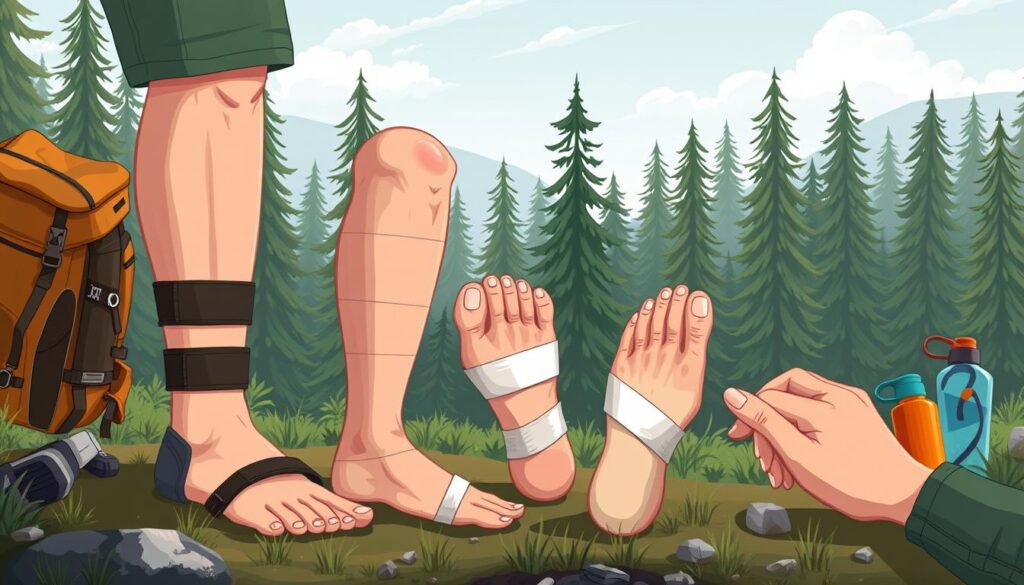
Every year, around 5,000 people get hurt while hiking in the United States. This shows the dangers of outdoor adventures. Hikers often face sprained ankles, cuts, scrapes, and dehydration. Falls are a big worry, especially on uneven or slippery trails.
Many injuries come from not warming up enough or wearing the wrong shoes. This can cause blisters and sprains. Also, hiking too hard without rest can lead to exhaustion and muscle cramps. Having a first aid kit with essentials can help treat these hiking injuries.
It’s important to treat small problems quickly to avoid bigger issues. For example, not cleaning a wound can lead to infection. If you have a serious injury, like a fracture or allergic reaction, you need to see a doctor. Knowing how to treat common injuries hiking can help you heal faster.
| Common Hiking Injuries | Symptoms | First Aid Kit Essentials |
|---|---|---|
| Sprains (ankles, knees) | Pain, swelling, limited mobility | Elastic bandages, ice packs |
| Cuts and Scrapes | Bleeding, redness, swelling | Adhesive bandages, antiseptic wipes |
| Blisters | Fluid-filled bubbles on skin | Moleskin, blister pads |
| Dehydration | Thirst, dry mouth, fatigue | Hydration salts, water purification tablets |
| Insect Bites | Itching, swelling | Antihistamines, insect sting relief |
Having a well-stocked first aid kit is key to staying safe while hiking. Taking care of your health on the trails makes for a better outdoor experience. It helps avoid the problems caused by hiking injuries.
Essential First-Aid Kit: A well-stocked first-aid kit, for your Adventure
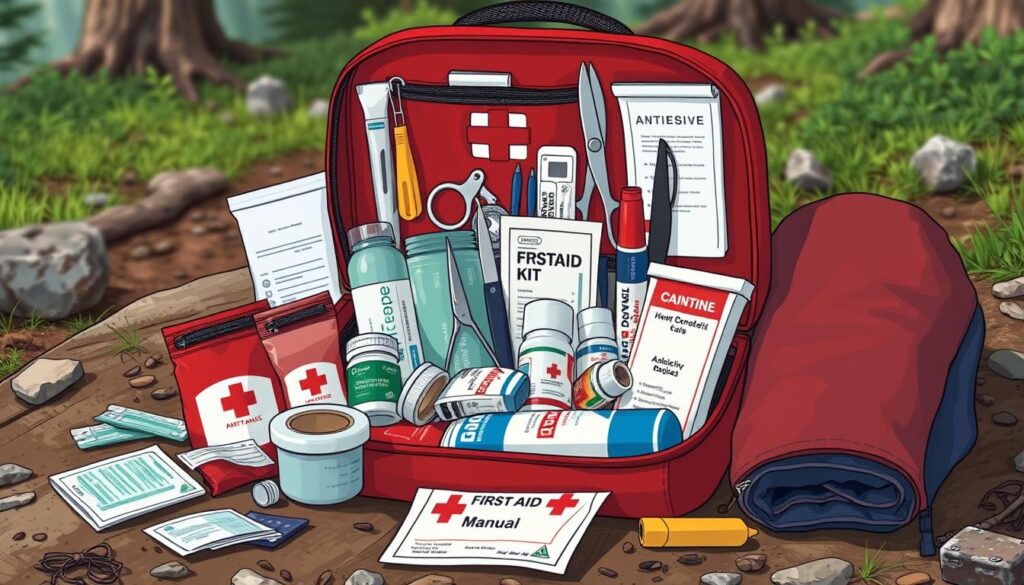
Having the right supplies is key for outdoor adventures. Knowing what to include in a first-aid kit helps you handle common injuries. A well-organized kit not only meets immediate needs but also gives you peace of mind.
Basic First-Aid Kit Essentials for Hiking
Every outdoor lover should have these important items in their first-aid kit:
- Adhesive bandages
- Sterile gauze pads
- Antiseptic wipes
- Pain relief medications
- Tweezers
- Blister pads
- Moleskin
These are the basic must-haves for any first-aid kit, whether at home or on the trail. Knowing what they are helps you respond quickly to injuries, making your adventures better.
Customizing Your Kit for Specific Needs
Your first-aid kit should be tailored to your needs. For example, if you’re hiking in a remote area, add an emergency blanket or a snake bite kit. This makes your kit more effective for emergencies.
Popular Pre-packaged First-Aid Kits
Looking for an easy option? Many pre-packaged first-aid kits are a good starting point:
| First-Aid Kit | Price ($) | Overall Score | Strengths |
|---|---|---|---|
| Surviveware Small | 50 | 80 | Quality, assortment, versatility, durability |
| Johnson & Johnson All-Purpose | 16 | 68 | Quality, assortment, versatility |
| Adventure Medical Kits Mountain Series Hiker | 30 | 65 | Quality, weight |
| MyMedic MyFAK | 170 | 78 | Quality, assortment, versatility |
| Homestock+ Professional | 34 | 71 | Assortment, versatility, durability |
| Adventure Medical Kits Ultralight/Watertight .7 | 34 | 60 | Weight |
Whether you choose the Surviveware Small kit for its high rating or the Johnson & Johnson kit for its price, these kits are a good start. Pick one that fits your needs to be ready for any outdoor mishap.
What to Include in Your First-Aid Kit for Different Activities
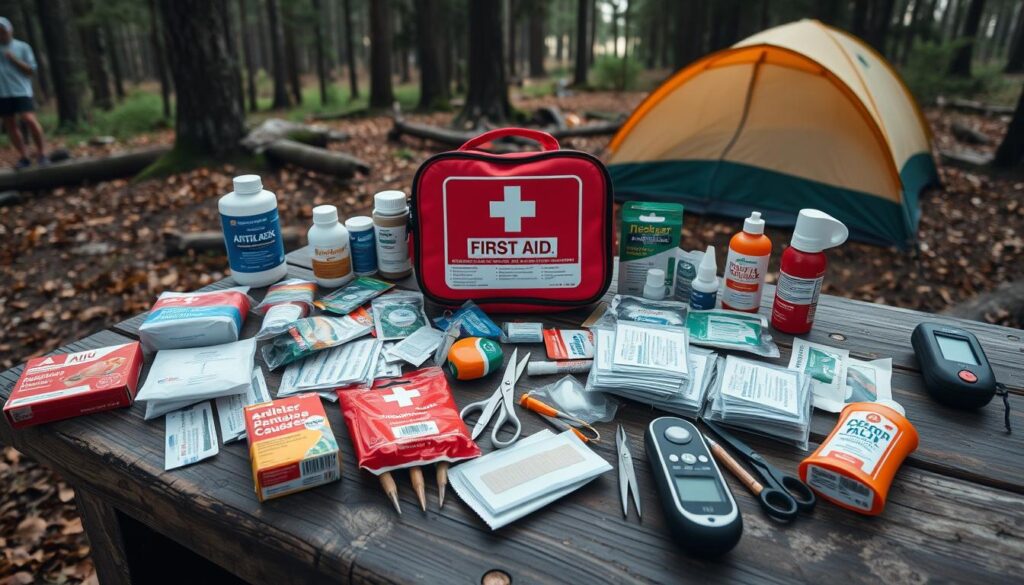
When you’re planning different activities, your first-aid kit needs to be ready. Whether you’re going camping or traveling, the right supplies are key. For camping, you’ll need items for common injuries. For travel, focus on what you might face on the road or in the air.
Knowing what to pack for each activity helps you make a list of must-haves. This way, you’re always ready for any situation.
First-Aid Essentials for Camping
Camping comes with its own set of challenges. A well-stocked first-aid kit is a must. Here are some essentials:
- Bandaids and gauze for cuts and scrapes
- EPIPen for allergic reactions
- Pain relievers like ibuprofen or acetaminophen
- Anti-diarrheal medication and antihistamines
- Eye drops for irritation
- Insect repellent to ward off bites
- Aloe gel for sunburn treatment
- CPR face shield for emergencies
For longer trips, add items like burn gel, heating pads, and sterile saline solution. Don’t forget a multi-tool knife, flashlight, and extra batteries.
Travel First-Aid Kit Must-Haves
Traveling, especially abroad, requires a special first-aid kit. Include:
- Emergency contact list with local healthcare numbers
- Travelers’ diarrhea remedies
- Motion sickness medication
- Antibiotic ointment for minor wounds
- Personal prescription medications
Remember, kits can sit unused for a while. So, check them often to make sure everything is still good to use. Being prepared can make a big difference in stressful situations.
Essential First Aid Skills for Outdoor Safety
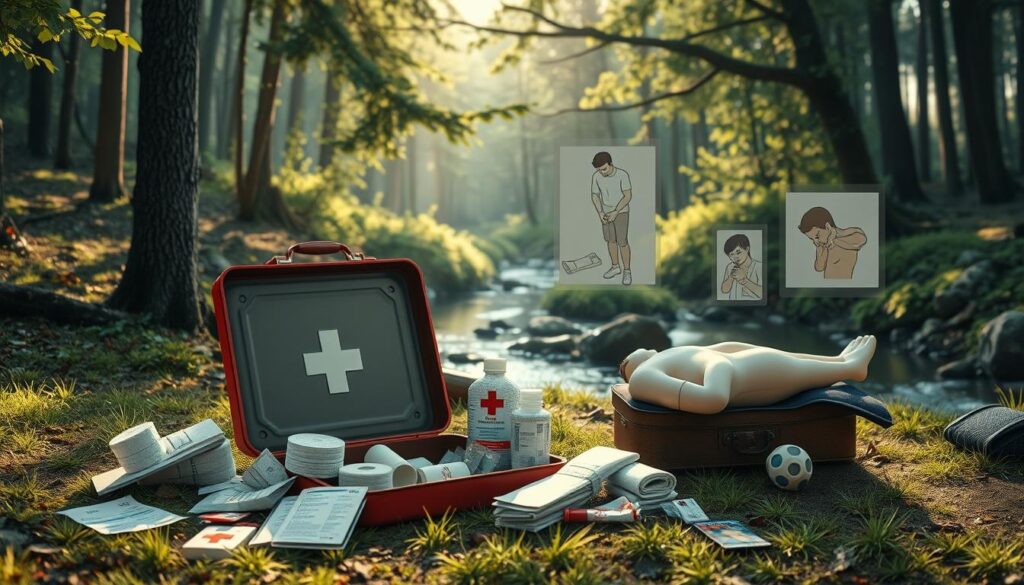
Going on outdoor adventures means you need to know first aid. You might face situations where fast action and knowledge are key. Knowing how to treat wounds, splint broken bones, and handle allergies can give you confidence in emergencies.
Outdoor first aid is about knowing the dangers of different activities. Injuries from hiking, camping, and sports often need quick help. Knowing CPR can save lives, especially in places far from medical help.
These moments need quick action, and being ready can help a lot.
- Learn basic wound care and how to dress injuries properly to prevent infections.
- Practice splinting techniques to stabilize fractures effectively.
- Understand the signs of an allergic reaction and how to use an epinephrine auto-injector.
Studies show that first aid training helps in outdoor emergencies. This training makes you safer and lets you help others. Planning your adventure means knowing how to stay hydrated and follow wildlife rules.
Joining a wilderness first aid course, like those by the American Red Cross, is smart. These courses give you hands-on practice and prepare you for real emergencies. Get the essential first aid skills to make your outdoor adventures safer.
The Importance of Training in First-Aid Skills
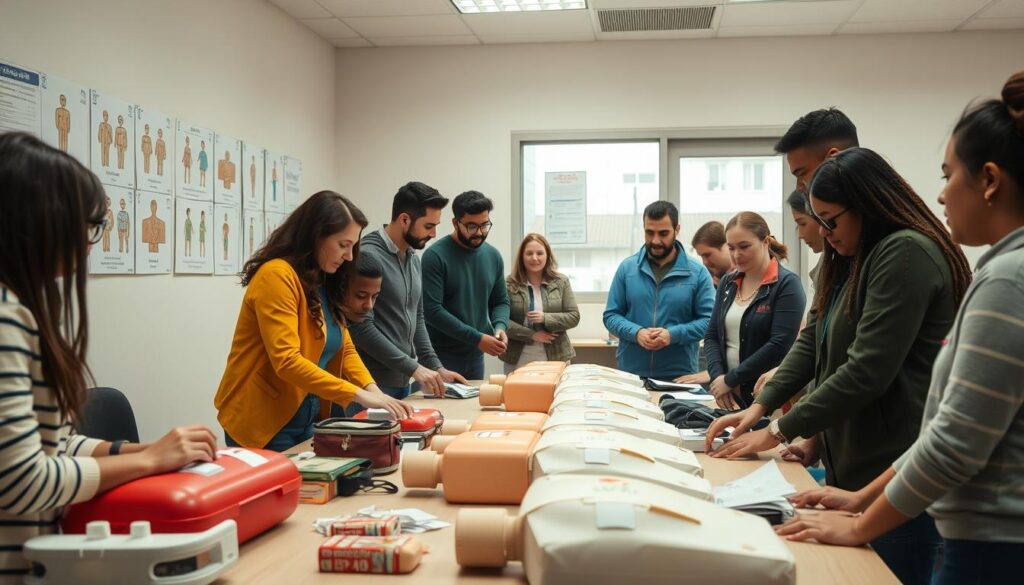
Knowing how to handle emergencies is key for outdoor lovers. First aid training teaches you essential first aid skills for different situations. It helps you use your first aid kit well.
Since breathing emergencies make up 21% of outdoor incidents, CPR training is vital. It can be a lifesaver in urgent moments.
Being ready for emergencies is part of planning your adventures. A big 30% of outdoor injuries are from bleeding. Learning how to stop bleeding is crucial.
Training programs teach you how to handle injuries like fractures and sprains, which happen in 15% of outdoor accidents. They also boost your skills in managing emergencies by up to 60%.
Only 40% of outdoor enthusiasts carry the right first aid kits. Training can help close this gap. It makes you more confident in outdoor settings.
Training covers everything from CPR to burn care, making outdoor adventures safer. Specialized first aid kits match this training. Whether it’s wilderness first aid or workplace needs, knowing how to act is essential.
How to Maintain and Organize Your First-Aid Kit
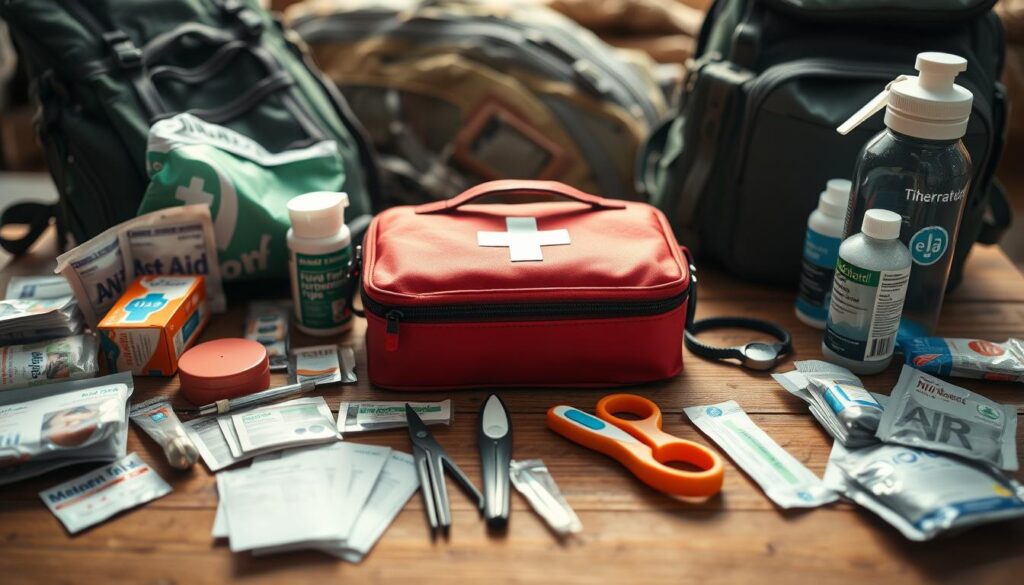
A well-maintained first-aid kit is a trusted friend on all your adventures. It’s important to check the supplies regularly. Set a reminder to review your kit every six months or when your health needs change. This check should include:
- Inspecting expiration dates on medications and ointments.
- Replacing used items right after any incidents.
- Checking the condition of bandages and other essentials.
Organizing your first aid supplies well makes your kit more useful in emergencies. Here are some tips:
- Put items in groups like bandages, medications, and tools for easy access.
- Use clear or labeled containers for easy identification of contents.
- Make a checklist of first aid kit essentials to ensure nothing is missed.
Having items like sterile dressing pads and antiseptic wipes in a neat way helps a lot. A first aid kit for hiking or overnight trips might have a 35 cc irrigation syringe for cleaning wounds. Also, keep a Wilderness First Aid booklet in your kit for quick reference.
Going to training courses by organizations like the Wilderness Medicine Training Center can help you understand emergencies better. This knowledge, along with the physical supplies, makes sure you’re ready for anything.
Creative Ways to Personalize Your First-Aid Kit

Making your first aid kit personal can turn it into a valuable tool. Start by adding creative first aid kit ideas that match your lifestyle. Include items that comfort you or fit your preferences. This makes your kit more useful and enjoyable.
Think about adding flavored electrolyte packets for long hikes or blister pads for sore feet. A waterproof notepad is great for jotting down medical info or documenting your trips. This first-aid kit customization makes your kit more functional and fun to use.
Check your essential supplies like ibuprofen, bandages, and antiseptic wipes. Tailor the medications to your needs, including personal ones. Remember to check expiration dates before each trip to stay safe.
With a bit of creativity, your first aid kit becomes a trusted friend on outdoor adventures. Personalize it to show your health and safety approach. Make sure it meets all your needs.
Conclusion
When you go on outdoor adventures, having a good first-aid kit is key. A well-prepared kit keeps you safe and ready for anything. It should have everything you need for wounds, medications, and more, for both you and your pets.
Knowing how to use your first-aid kit is just as important. Learn the basics and practice before you go. This way, you can handle small injuries and be ready for bigger ones, making your trip safer.
Make your first-aid kit your own, updating it for each adventure. With the right kit and skills, you can enjoy the outdoors safely. Remember, safety first, and you’ll have amazing memories in nature.

